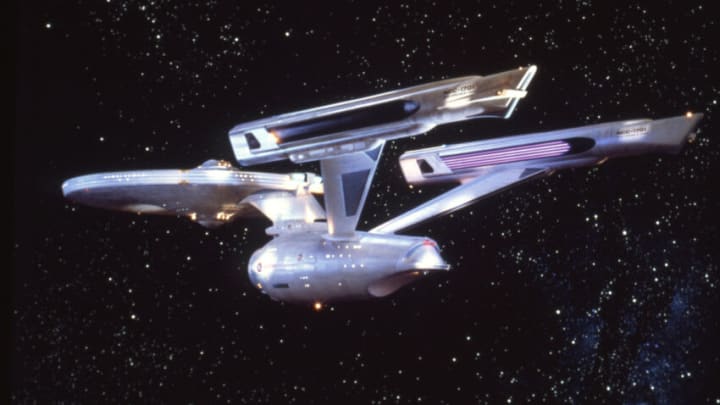Star Trek The Motion Picture Director’s Edition is an immersive delight
By Mike Poteet

Star Trek The Motion Picture Director’s Edition delivers on 1979 ad promises.
One of the original TV ads for Star Trek The Motion Picture featured Orson Welles intoning, “It will startle your senses, challenge your intellect, and alter your perception of the future—by taking you there.”
I first saw that ad, on the 2001 DVD debut of the Director’s Edition. I considered it mere marketing hyperbole. But now that I’ve seen the remastered Star Trek The Motion Picture Director’s Edition on an honest-to-Great Bird of the Galaxy big movie screen, I think the world finally has a version of the movie that lives up to that hype.
I couldn’t tell you how many times I’ve seen ST:TMP over the 30-odd years I’ve been a Trek fan. But seeing this lovingly and brilliantly remastered version of the movie in a movie theater truly was almost like seeing it for the first time.
I admit my statement sounds, even to me, like hyperbole worthy of a 1979 TV ad. But watching Star Trek The Motion Picture Director’s Edition at a movie theater, I was engaged with and engrossed in the movie as I have never been before—not even when I streamed this edition at home on Paramount Plus last month. Twice!
Delightful Discoveries in the Star Trek The Motion Picture Director’s Edition
You can find (and, by this late date, likely have found) plenty of articles online running down the changes in this remastered Director’s Edition: what they are, how the creative team accomplished them, and whether fans like them. But what impressed me most in this, my first-ever theatrical viewing of ST:TMP, was the overall immersive experience it created.
The sound mix is spectacular, for starters. I heard ambient noises and background chatter on the Enterprise I’d never heard before. They added so much aural texture—especially two brief lines from Chekov (one as Kirk descends into Engineering; the other as Kirk, Spock, McCoy, and Ensign Perez enter Ilia’s cabin) that make the newly minted security chief seem that much more involved in the action.
And the superb, Academy Award-nominated score by Jerry Goldsmith has never sounded better. The first violin notes in the Overture (Ilia’s Theme) alone were smooth and rich enough to make me misty-eyed.
None of the enhanced visual effects caught me by surprise, but they are indeed beautiful to behold on a big screen. The Enterprise’s pearlescent paint job really does shimmer, and at several points late in the film, the ship takes on an overall golden, gorgeous hue.
Some sights that did surprise me were glimpsing new acting choices the performers’ faces. It can’t be denied ST:TMP relies too much on reaction shots. But seeing them on a 30-foot-tall screen at least allows one to notice new details.
All conventional criticisms of William Shatner as a “ham” aside, he does some incredibly subtle things with his eyes and mouth (especially during the marvelous inspection tour of the refit Enterprise). Likewise, Persis Khambatta communicates enormous emotion when she, as the Ilia probe, furrows her brow ever so slightly when the landing party talks about “the Creator” coming to V’Ger personally near the end.
So, yes—my senses were startled.
Star Trek The Motion Picture has always been the most intellectually ambitious movie in the franchise. But I found it easier to allow myself some philosophical musings while watching the Director’s Edition on a movie screen. Perhaps because all the sights and sounds were so crisp, clean, and big, they subconsciously encouraged me to immerse myself in big thoughts, right along with Kirk, Spock, and the others.
And as for taking me to the future?
I was fortunate to be able to attend the final Fathom Events screening in my area—with my teenage daughter, no less. Her Trek of choice is Deep Space Nine, but I thought she wanted either to humor Dad or have a good reason to stay up late on a school night. Or maybe both. But we both had a fantastic time. She even said to me as we left the theater, “It didn’t seem slow at all!”
Now, I admit: I still find the Enterprise’s parallel flyover of V’Ger a tad sluggish. I’m not sure what I’d cut without mangling Goldsmith’s gorgeous music, but surely some frames here and there could stand to go.
That quibble aside, I agree with my daughter. The Star Trek The Motion Picture Director’s Edition feels, not fast, but correctly paced, because it’s not just about an Enterprise adventure. It’s an immersion (there’s that word again) in the 23rd century—Klingon battle cruisers, Federation space stations, Starfleet headquarters, the planet Vulcan, orbital drydocks, and all.
Watching ST:TMP, we’re tourists in the 23rd century! Why wouldn’t we want to take our time?
This definitive Star Trek The Motion Picture Director’s Edition does everything Orson Welles promised audiences it would back in 1979. Perhaps, like the Paul Masson wine Welles also advertised, this film was always a product that should not have been sold before its time.
Thankfully, with the remastered Star Trek The Motion Picture Director’s Edition, its time has finally arrived!
Next. Star Trek shows behind-the-scenes images of Star Trek: The Motion Picture’s restoration. dark